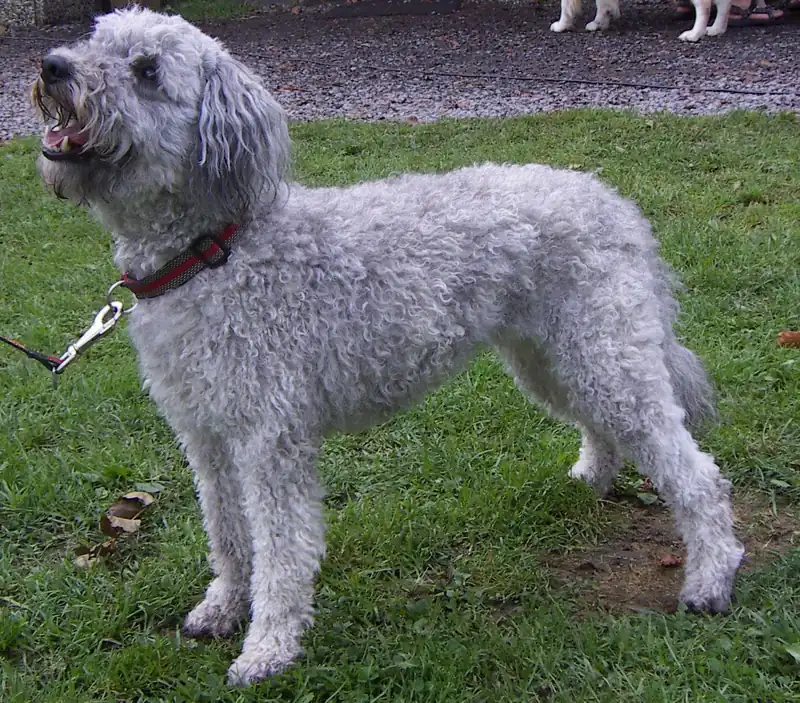Briard
The Briard is a large, ancient French herding dog known for its loyalty, intelligence, and protective nature. With a long, flowing coat and a robust build, this breed excels in herding and guarding livestock. Briards require regular exercise and grooming, making them ideal companions for active families.
Overview
🐕Breed Overview
✨Key Traits
💡What Makes Briard Special
The Briard's key traits include its strong herding instincts, intelligence, and loyalty. They are naturally protective of their families and can be aloof with strangers, making early socialization essential.
Their independent thinking allows them to work autonomously, which is a valuable trait in herding situations. Briards are also known for their affectionate nature, often forming strong bonds with their owners.
Their versatility enables them to excel in various roles, from herding to serving as therapy dogs. These traits make them well-suited for active families who can provide the necessary training and socialization.
The Briard is a majestic and ancient breed of large herding dog, originally hailing from France. With a rich history dating back to the 1300s, the Briard has been a loyal companion to shepherds, guarding livestock and property against predators. This breed is characterized by its long, flowing coat, which can be tawny, black, or gray, and its robust, rustic appearance.
Standing between 22 to 27 inches tall and weighing between 50 to 100 pounds, the Briard is both powerful and agile, making it well-suited for its original herding tasks. Briards are known for their intelligence and independent thinking, which can sometimes make training a challenge. They are loyal and protective of their families, often forming strong bonds with their owners.
While they can be reserved with strangers, their affectionate nature shines through with those they know and trust. Early socialization and consistent training are essential to help them develop into well-rounded companions. This breed thrives in active households, requiring daily exercise and mental stimulation to keep them happy and healthy.
Activities such as herding trials, agility courses, and long walks are ideal for meeting their exercise needs. Grooming is also an important aspect of Briard care, as their long coat requires regular brushing to prevent matting. Briards have a moderate energy level and are known for their playful and affectionate demeanor.
They are generally good with children, making them excellent family pets, but they may exhibit herding behaviors, such as nipping at heels, if not properly trained. With a lifespan of 10 to 12 years, the Briard is a devoted companion that brings joy and loyalty to those fortunate enough to share their lives with them.
🎉Fun Facts
Briards have been featured in various films and television shows, showcasing their versatility and charm.
The Briard is known for its unique double dewclaws on each hind leg, which aid in agility and stability.
This breed is often referred to as having a 'heart of gold wrapped in fur' due to its loving nature.
Breed Characteristics
Family & Friends
Good Behavior
Get Up & Go
Household Harmony
Temperament & Personality
✨Key Traits
🐕Core Temperament
The Briard is a devoted and faithful breed, known for its gentle and loving nature. They are intelligent and independent, often displaying a strong will.
While they are protective of their families, they can be reserved with strangers, requiring proper introductions. Briards are known for their playful demeanor and can be quite affectionate with children, making them excellent family pets.
However, their herding instincts may lead them to nip at heels or try to herd family members, which should be managed through training and redirection.
💫Personality Profile
Briards are known for their loyalty and protective instincts, making them excellent family companions. They are affectionate with their families but can be reserved with strangers.
Their independent nature means they may not always follow commands immediately, requiring consistent training and socialization. Briards are intelligent and can learn quickly, but they may also exhibit stubbornness.
They thrive in active households where they can engage in physical and mental activities. Their playful demeanor makes them great with children, although they may try to herd them at times.
🔊Vocal Tendencies
Briards are generally moderate barkers. They may bark to alert their owners of strangers or unusual sounds, but they are not known to be excessive barkers.
Their vocalizations can vary depending on the situation; for example, they may bark excitedly during play or when greeting family members. However, they tend to be quieter indoors and may only bark when necessary.
Proper training can help manage their barking tendencies, ensuring they are well-behaved in various environments.
Affection & Social Traits
Energy & Activity
Communication Style
Care Requirements
🏃♂️Exercise Requirements
Daily Exercise
The Briard is an active and energetic breed that requires a significant amount of exercise to maintain its physical and mental well-being. Ideally, they should engage in at least 60 to 90 minutes of exercise daily, which can include long walks, jogs, or play sessions. Activities like herding trials, agility courses, and obedience training are excellent for keeping them stimulated.
Puppies may require shorter, more frequent exercise sessions to accommodate their developing bodies, while senior dogs may benefit from gentler activities to avoid strain. Regular exercise helps prevent behavioral issues such as boredom and anxiety, which can lead to destructive behaviors. Insufficient exercise can result in weight gain, restlessness, and increased barking or other undesirable behaviors.
Therefore, it is crucial for owners to provide a structured exercise routine to keep their Briard happy and healthy.
Preferred Activities
🏠Living & Adaptability
Space Requirements
Briards are large dogs that thrive in spacious environments. They require ample room to move around, so a home with a large yard is ideal.
While they can adapt to apartment living if given sufficient exercise, they may become restless without enough space to roam freely. Owners in smaller living situations should ensure they have access to parks or open areas for regular exercise.
The breed's size and energy level necessitate a living environment that allows for physical activity and mental stimulation. Without adequate space, Briards may exhibit destructive behaviors or anxiety due to confinement.
Climate Preference
🍲Feeding Guide
Schedule
Food Types
Portion Size
Special Nutritional Needs
Briards may have specific dietary requirements due to their size and activity level. A high-protein diet is recommended to support their energy needs, especially for active dogs.
Owners should monitor their Briard for any food sensitivities or allergies, and consult with a veterinarian for tailored dietary advice. Supplements such as omega fatty acids can help maintain a healthy coat.
✨Grooming Requirements
Grooming Overview
The Briard's long, thick coat requires regular grooming to prevent matting and maintain its health. Owners should brush their Briard's coat at least every other day, using a slicker brush and a comb to remove tangles and debris.
Bathing should be done as needed, typically every few months, using a gentle dog shampoo. Regular nail trimming and ear cleaning are also essential to keep the dog comfortable and healthy.
Grooming sessions can be a bonding experience, allowing owners to check for any skin issues or parasites while maintaining the coat's appearance.
Care Schedule
Brush every other day; bathe every 1-3 months; trim nails every 2-4 weeks.
Health Profile
⚕️Health Care
Regular health care is vital for the Briard's longevity. Routine veterinary check-ups, vaccinations, and preventive treatments can help detect and address health issues early.
Owners should also monitor their dog's weight and overall health, adjusting diet and exercise as needed. Regular dental care and grooming are essential components of a comprehensive health care routine, contributing to the dog's overall well-being.
Health Issues Overview
⏳Average Lifespan
Genetic Factors
Genetics play a significant role in the Briard's lifespan, with hereditary health issues such as hip dysplasia and progressive retinal atrophy being common concerns. Responsible breeding practices that prioritize genetic diversity and health testing can help reduce the prevalence of these conditions. Potential owners should seek reputable breeders who conduct health screenings and provide information about the lineage of their puppies to ensure a healthy start.
Living Conditions
The Briard's lifespan can be influenced by various environmental factors, including housing conditions, climate, and activity levels. A well-maintained living environment with ample space for exercise and play can promote longevity.
Exposure to extreme temperatures should be minimized, as Briards are more tolerant of cooler climates than heat. Regular social interaction and mental stimulation are also crucial for their overall well-being, contributing to a longer, healthier life.
🏥Common Health Issues
Hip Dysplasia
Warning Signs
🔬Diagnosis
X-rays and physical examination by a veterinarian.
💊Treatment
Medications, weight management, and in severe cases, surgery.
📝Management Tips
Maintain a healthy weight, provide joint supplements, and avoid excessive jumping or strenuous activities.
Progressive Retinal Atrophy (PRA)
Warning Signs
🔬Diagnosis
Veterinary eye examination and genetic testing.
💊Treatment
No cure, but supportive care can help.
📝Management Tips
Regular veterinary check-ups and monitoring for vision changes.
Gastric Torsion (Bloat)
Warning Signs
🔬Diagnosis
Physical examination and imaging by a veterinarian.
💊Treatment
Emergency surgery is often required.
📝Management Tips
Feed smaller, more frequent meals and avoid vigorous exercise after eating.
🛡️Preventive Care
🔬Hip Evaluation
Hip Evaluation to assess for hip dysplasia, a common issue in large breeds.
📅 Every 1-2 years, starting at 2 years of age.
🔬Ophthalmic Examination
Eye examination to screen for progressive retinal atrophy and other eye conditions.
📅 Annually, starting at 2 years of age.
🔬Cardiac Evaluation
Cardiac evaluation to check for any hereditary heart conditions.
📅 Every 1-2 years, especially in older dogs.
Training
🧠Intelligence & Trainability
💪Work Drive
Briards have a strong work drive, stemming from their herding and guarding instincts. They thrive when given tasks to complete, whether it's herding livestock, participating in agility trials, or engaging in obedience training.
Mental stimulation is just as important as physical exercise for this breed. Providing puzzle toys, interactive games, and opportunities for problem-solving can help keep their minds sharp and prevent boredom.
Without sufficient mental engagement, Briards may resort to undesirable behaviors, such as chewing or digging.
⚠️Training Considerations
Briards can exhibit some behavioral challenges, particularly due to their independent nature. They may be stubborn or strong-willed, making training a bit of a challenge for inexperienced owners.
Consistent and positive reinforcement training methods are essential to overcome these obstacles. Socialization from a young age is crucial to help them become well-rounded adults.
They may also display herding behaviors, such as nipping at the heels of children or other pets, which can be managed through proper training and redirection. Owners should be patient and understanding, as harsh training methods can lead to anxiety and behavioral issues.
📝Training Tips
Training a Briard requires patience, consistency, and a firm yet gentle approach. Start with basic obedience commands and gradually introduce more complex tasks.
Use positive reinforcement techniques, such as treats and praise, to encourage desired behaviors. Socialization is vital; expose your Briard to various environments, people, and other animals to help them become well-adjusted.
Short, engaging training sessions are more effective than lengthy ones, as Briards can become bored or distracted. Consider enrolling in obedience classes to provide structure and guidance for both the dog and the owner.
History & Heritage
📜Origin Story
The Briard's origins can be traced back to ancient times, with its ancestors believed to have accompanied nomadic tribes during migrations across Europe. The breed was developed in the Brie region of France, where it was used as a herding and guarding dog.
Legend has it that a Briard avenged its owner's murder in a judicial duel, showcasing its loyalty and bravery. The breed gained recognition in the 14th century, and notable figures such as Charlemagne and Napoleon kept Briards as companions and protectors.
The breed's journey to the United States is attributed to early American leaders like Thomas Jefferson and the Marquis de Lafayette, who brought Briards to America in the late 18th century. Today, the Briard is celebrated for its intelligence, loyalty, and versatility, making it a beloved companion and working dog.
⏳Development History
The Briard is one of the oldest French herding breeds, with records dating back to the 1300s. Originally known as the 'chien berger de Brie,' the breed was developed to guard livestock and property.
Over the centuries, the Briard's role evolved from a fierce protector against wolves and intruders to a more gentle herder. The breed was officially recognized in the early 20th century, and its first standard was written in 1897.
Despite its historical significance, the Briard's popularity has fluctuated, and it remains a cherished breed in France, particularly among shepherds.
🛡️Purpose & Historical Role
Historically, the Briard was bred for herding and guarding livestock, particularly sheep. Its ability to work independently and protect flocks from predators made it an invaluable asset to farmers.
The breed's natural instincts allowed it to herd large groups of animals without human intervention, showcasing its intelligence and adaptability. In modern times, the Briard has taken on various roles, including service dog, therapy dog, and companion, while still excelling in herding trials and other canine sports.
🏺Cultural Significance
The Briard is an ancient breed with a rich history, believed to have been favored by notable historical figures such as Charlemagne and Napoleon Bonaparte. Its presence in French culture is significant, as it has been depicted in art and literature for centuries.
The breed's role as a herding and guarding dog has made it a symbol of loyalty and protection in rural France. Today, the Briard continues to be celebrated for its versatility, serving not only as a working dog but also as a beloved family companion.
Its unique characteristics and historical importance contribute to its cultural significance in France and beyond.
Conservation Status
This breed is less common but has stable populations in certain regions.









